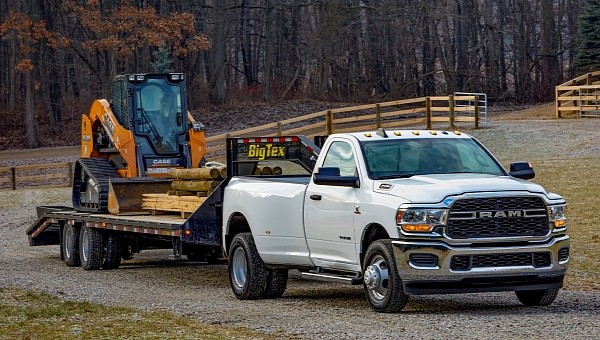Cummins’ new B6.7H hydrogen engine seems like the ideal powerplant for the future hydrogen-powered Ram Heavy Duty truck. Derived from the 6.7-liter diesel powerplant already featured in the current crop of Ram Heavy Duty trucks, the Cummins hydrogen engine promises a comparable performance level while being carbon-free.
While many people believe electric vehicles are the future of the automotive industry, others find the current EVs’ performance appalling, especially for heavy-duty tasks. The current electric pickup trucks have proven ill-suited for towing, which is the main quality of a full-size pickup truck. No matter the badge, GMC, Rivian, or Ford, electric pickup trucks lose more than half the range when towing a trailer. This is even more frustrating when you consider that the range was not great, to begin with, and the fact that charging stations are still few and far between in regions where trucks are dominant.
That’s why big carmakers have a more balanced approach when it comes to future-proofing their lineups, and battery-electric vehicles are not their only choice. Many still believe that hydrogen hasn’t yet shown its full potential. After fuel cell vehicles, internal combustion engines, which burn the hydrogen directly, could prove a better solution where electric vehicles still struggle to offer meaningful advantages.
This is a field that engine giant Cummins pioneered with great results. Cummins has developed hydrogen internal combustion engines for various applications, from small trucks to giant ships. Its hydrogen engines are almost identical to their fossil-fuel counterparts, except for the engine management unit and the components above the head gasket, which are optimized for efficiently burning the hydrogen.
The Cummins 6.7-liter ISB (Interact System B) diesel engine is the latest iteration of the B-series engines and is featured across the Ram 2500/3500/4500/5500 Heavy Duty truck lineup. Depending on specifications, it can deliver up to 400 horsepower, being the workhorse of the Ram HD lineup. The same engine is now available as a hydrogen burner and is known as the Cummins B6.7H. Very few modifications enable the B6.7 to run on hydrogen, making the new engine ideal to power future hydrogen versions of the Ram trucks.
For its part, Stellantis has indicated that it actively considers producing a hydrogen-powered truck. During the Dare Forward 2030 presentation in November, Stellantis talked about the company’s hydrogen strategy. The carmaker is already selling hydrogen-powered vans in Europe, albeit using fuel cells instead of an internal combustion engine. Nevertheless, over the long term, Stellantis is considering expanding its hydrogen offering, not least with a hydrogen-powered truck in the Ram HD lineup.
To be sure, Stellantis did not say whether the truck uses a fuel cell or an internal combustion engine. Nevertheless, considering that Cummins already makes a hydrogen-powered drop-in replacement for the diesel B6.7 engine, it makes sense to offer a truck powered by the B6.7H powerplant. This would provide the advantage of a carbon-free engine while still beating an electric truck regarding range and refueling time.
Cummins has already shown a proof-of-concept truck powered by the B6.7H engine. The hydrogen storage system comprises 700-bar pressure high-capacity tanks, allowing a 310-mile (around 500-km) range. The engine still delivers 290 horsepower, which is pretty similar to the equivalent diesel engine. Cummins used regular diesel driveline components in its prototype, which is another advantage over competing zero-emissions solutions.
That’s why big carmakers have a more balanced approach when it comes to future-proofing their lineups, and battery-electric vehicles are not their only choice. Many still believe that hydrogen hasn’t yet shown its full potential. After fuel cell vehicles, internal combustion engines, which burn the hydrogen directly, could prove a better solution where electric vehicles still struggle to offer meaningful advantages.
This is a field that engine giant Cummins pioneered with great results. Cummins has developed hydrogen internal combustion engines for various applications, from small trucks to giant ships. Its hydrogen engines are almost identical to their fossil-fuel counterparts, except for the engine management unit and the components above the head gasket, which are optimized for efficiently burning the hydrogen.
The Cummins 6.7-liter ISB (Interact System B) diesel engine is the latest iteration of the B-series engines and is featured across the Ram 2500/3500/4500/5500 Heavy Duty truck lineup. Depending on specifications, it can deliver up to 400 horsepower, being the workhorse of the Ram HD lineup. The same engine is now available as a hydrogen burner and is known as the Cummins B6.7H. Very few modifications enable the B6.7 to run on hydrogen, making the new engine ideal to power future hydrogen versions of the Ram trucks.
For its part, Stellantis has indicated that it actively considers producing a hydrogen-powered truck. During the Dare Forward 2030 presentation in November, Stellantis talked about the company’s hydrogen strategy. The carmaker is already selling hydrogen-powered vans in Europe, albeit using fuel cells instead of an internal combustion engine. Nevertheless, over the long term, Stellantis is considering expanding its hydrogen offering, not least with a hydrogen-powered truck in the Ram HD lineup.
To be sure, Stellantis did not say whether the truck uses a fuel cell or an internal combustion engine. Nevertheless, considering that Cummins already makes a hydrogen-powered drop-in replacement for the diesel B6.7 engine, it makes sense to offer a truck powered by the B6.7H powerplant. This would provide the advantage of a carbon-free engine while still beating an electric truck regarding range and refueling time.
Cummins has already shown a proof-of-concept truck powered by the B6.7H engine. The hydrogen storage system comprises 700-bar pressure high-capacity tanks, allowing a 310-mile (around 500-km) range. The engine still delivers 290 horsepower, which is pretty similar to the equivalent diesel engine. Cummins used regular diesel driveline components in its prototype, which is another advantage over competing zero-emissions solutions.








